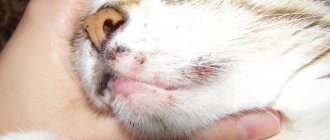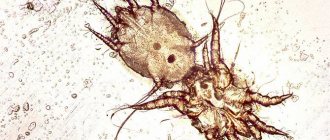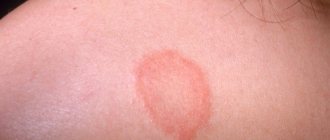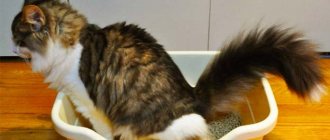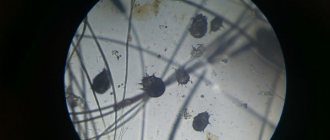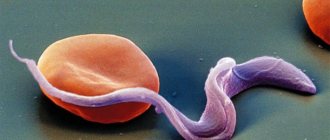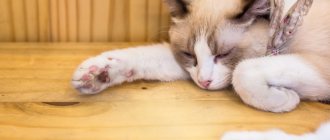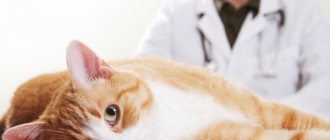Causes
The disease is characterized by a number of predisposing factors that do not themselves lead to glaucoma, but the likelihood of its occurrence increases. The disease is often associated with breed; Siamese, Burmese, Persian and European Shorthairs are most susceptible. The onset of the disease is not limited by age and can occur at any age.
The list of the most common causes of glaucoma includes:
- Reduced natural outflow of fluid from the inner chamber of the eye.
- Congenital developmental anomalies in which the drainage of intraocular fluid is disrupted.
- Pathological diseases of the eye - uveitis, lens luxation and tumor.
- Traumatic injury.
The main cause of glaucoma is uveitis (inflammation of the anterior chamber of the eye) accompanied by clouding of the lens.
Diagnosis and treatment of glaucoma in cats
The goal of treating glaucoma is to lower intraocular pressure, alleviate the animal’s condition and, if possible, preserve its vision.
Therapy consists of drugs that reduce intraocular pressure, as well as drugs that correct common diseases. Treatment for complications of glaucoma consists of treating anterior uvitis, removing the affected lens, or extracting the eyeball for tumors. If it is impossible to correct the condition of the eye and there is a persistent increase in intraocular pressure, the eye must be removed in order to eliminate the source of constant pain for the animal.
Drugs that relieve intraocular pressure can be:
- drops that increase the outflow of fluid from the eye;
- drugs that reduce the amount of intraocular fluid produced;
- medications that constrict the pupil;
- painkillers and restoring nerve conduction;
- vitamin eye drops that help restore vision or stop the progression of blindness;
- diuretics that help reduce intraocular pressure by activating the urinary system;
- antibiotics;
- anti-inflammatory corticosteroid drugs.
When carrying out antiglaucoma therapy, the intake of water into the cat’s body should be strictly controlled. She should not drink a lot of water during this period. Excess fluid may negate the effectiveness of treatment.
Classification
There are 2 types of glaucoma: primary - congenital, and secondary. The first type is observed extremely rarely and is mainly associated with genetic disorders and congenital developmental anomalies in the iridocorneal angle.
Secondary glaucoma is most often associated with eye disease and is the result of injury or inflammation.
Unilateral and bilateral eye damage is also possible. When both eyes are involved, one organ is more affected than the other.
Treatment with folk remedies: reviews from owners
In the comments, cat owners often ask about folk remedies to combat glaucoma. The fact is that this disease cannot be cured in this way. However, reviews say that with the help of traditional medicine it is possible to enhance the effect of drug therapy. So, let's look at what the owners advise.
- Wash your eyes with aloe decoction several times a day.
- Infuse strong tea with honey and drop a few drops into each eye.
This, of course, will not help get rid of glaucoma, but it will reduce inflammation and pain. The owners claim that the animals are becoming calmer.
Symptoms
For a long time, the disease can behave hiddenly, without manifesting itself outwardly. Typically, cat owners come to the clinic with the detection of strabismus in their pet, redness of the eyes, but in most cases the early stages are asymptomatic.
Clinical signs of glaucoma include:
- One of the first symptoms is mydriasis - a significant dilation of the pupil and its lack of reaction to light.
- Watery eyes and photophobia appear.
- Redness of the sclera of the eye is possible, but is rare in cats.
- Corneal edema.
- An increase in the size of the eyeball is characteristic of the chronic course of glaucoma.
- Reduced visual acuity to the point of blindness.
- Pain - the cat may squint its eye or look depressed; cats tolerate this symptom with steadfastness, as they can endure pain for a long time and calmly use one eye.
Congenital and primary glaucoma in most cases are chronic in nature, often complicated by complete loss of vision.
Forecast
In the secondary form of glaucoma, the prognosis for a cat is often unfavorable. With early treatment of uvitis, glaucoma can be reversible. The animal manages, although not fully, to retain its vision.
We suggest you read: Malocclusion in a puppy, types of causes and methods of correction
It all depends on the stage of glaucoma at the time of contacting the clinic. Permanent medical treatment or surgical treatment for glaucoma may be offered if visual function is preserved. However, today any treatment for glaucoma is not a treatment in the sense that we would like to understand this word. That is, we cannot undergo treatment and recover. You will need treatment for the rest of your life, perhaps with varying degrees of success.
In the same case, if at the time of admission the cat has no vision, the eye causes pain, and is enlarged in size, such a patient is offered removal of the eye as a radical but effective measure to relieve pain and the risk of eye perforation. Lifelong medical treatment or a series of surgical operations on the blind eye is unlikely to be a good plan for such a patient and its owner.
Diagnostics
The diagnosis of glaucoma is made only after confirmation of the disease by measuring intraocular pressure. Before this, the attending physician can only assume the presence of the disease, but diagnoses it on the basis of an increase in pressure.
Similar diseases and their differences:
- Conjunctivitis - redness affects only the conjunctiva of the eye without swelling. Easily treated with local anesthetics.
- Inflammation of the anterior chamber (uveitis) is usually accompanied by decreased pressure inside the eye and miosis (constriction of the pupil).
- Dystrophic changes in the cornea - accompanied by a normal level of intraocular pressure and absence of pain.
- Ulcerative keratitis - pain and discomfort in the eye are relieved with drops of anesthetics; when stained with a special dye with a fluorescent substance, a positive reaction is detected - the damaged areas are painted more intensively.
One of the main methods for assessing intraocular pressure is tonometry. It is performed with local anesthesia - instillation of inocaine or benoxy into the eyes. It is measured with a special device - a Shiotz or Tono-Pen tonometer.
Normal intraocular pressure ranges from 15 mm Hg. Art. up to 25 mm Hg Art. If the difference between the measurement of both eyes is more than 10 mmHg. Art., that is, the basis for diagnosing glaucoma.
Gonioscopy is used to examine the iridocorneal angle. Such a study is carried out to assess the likelihood of disease in the second eye with secondary glaucoma or with a hereditary predisposition to primary glaucoma and assess the risk of occurrence. To carry out the manipulation, special lenses are placed on the cat’s eye and, due to the refraction of light in them, they allow one to see the necessary anatomical formation.
Fundus examination gives the ophthalmologist an idea of the preservation of visual function and visualization of the optic disc. Edema or atrophic phenomena are an unfavorable sign and indicate deterioration with subsequent loss of vision.
Surgery
Unfortunately, nothing will help restore lost vision, but this does not mean that you do not have to deal with the accompanying symptoms. If the animal's health deteriorates significantly, surgery is performed to remove the affected eye. This will relieve him of constant pain and discomfort.
If vision has not yet begun to decline, then during surgery the surgeon either partially removes the ciliary body or drains the anterior chamber. This will help normalize intraocular pressure for a while.
Treatment
Anti-glaucoma therapy must be carried out on both eyes, even if only one is affected.
The prognosis of treatment and recovery is calculated based on the presence or absence of vision; with the latter, it is only possible to stabilize the condition and alleviate the general condition, but vision does not return.
The main goal of all drug therapy is to reduce intraocular pressure levels as much as possible. The closer its values are to normal, the greater the chances of maintaining vision and reducing pain.
Main groups of drugs for treatment:
- Osmotic diuretics - usually used for uncomplicated glaucoma and the absence of inflammation, prescribe mannitol - administered 1 gram per kilogram of body weight intravenously as a dropper for 30 minutes. It is an emergency medicine for lowering blood pressure and is not used for long-term therapy.
- Bimatoprost - belongs to the group of prostaglandins and helps the outflow of fluid. Not used for blocking the iridocorneal angle and uveitis. Instill 1 drop 2 times a day. If you find a strong constriction of the pupils, this will be one of the actions of prostaglandins and there is no need to worry.
- Preparations for pupil constriction - used topically, pilocarpine is usually prescribed - 1 drop in each eye once a day. They help increase the outflow of fluid by contracting the intraocular muscles.
- Beta blockers - betoxolol or temolol, use 1 drop every 12 hours, in severe conditions every 8 hours. They have minimal side effects and help reduce intraocular pressure.
- Amlodipine is a calcium channel blocker that helps speed up fluid outflow. Take 0.6 mg 1 time per day with food.
- Carbonic anhydrase inhibitors are diuretics and promote general fluid outflow. With long-term use, additional intake of potassium supplements (calcitriol) is recommended. Typically, the inhibitor used is methazolamide 5 mg/kg 2 times a day.
This drug therapy has a positive effect while maintaining vision and the absence of complications. If intraocular pressure constantly increases despite drug control, then surgical treatment is used.
Two methods are used - surgical drainage of the anterior chamber or partial removal of the ciliary body.
In case of a completely blind eye in conditions of primary or congenital glaucoma, complete removal of the damaged eye is used - this helps to remove pain and remove an unpleasant cosmetic defect. In secondary glaucoma, amputation of the eye is performed when it is complicated by lens dislocation.
If the cause of glaucoma is uveitis, then it is also necessary to prescribe anti-inflammatory drugs - diclofenac, ibuprofen topically.
Unfortunately, despite the measures taken, it is not possible to stop the decline in vision, but this treatment helps alleviate the cat’s condition. Mandatory regular monitoring by an ophthalmologist.
Prevention of glaucoma
To prevent the development of the disease, you should regularly show your cat to the veterinarian. A specialist will be able to detect the pathological process at an early stage and get rid of it in a timely manner. If the animal is at risk, you should visit the clinic at least 2 times a year.
Timely treatment of all emerging pathologies will help prevent the disease. Since glaucoma often occurs in cats suffering from other diseases, getting rid of them reduces the risk of eye problems.
All information posted on the site is provided in accordance with the User Agreement and is not a direct instruction to action. We strongly recommend that before using any product, you must obtain a face-to-face consultation at an accredited veterinary clinic.
